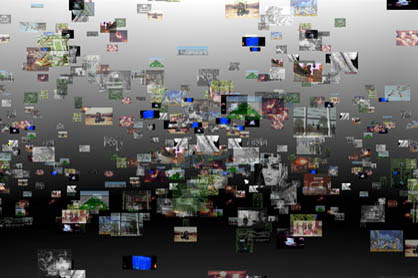|
|
||||||
| image | activities | contacts | links | italiano | ||||||
|
5th
International Festival for Architecture in Video |
||||||
|
introduction program - dates - authors - works - exhibitions partners credits previous editions mailto |
 Shohei Matsukawa, Fumio Matsumoto Ginga Japan 1999 Spatial representation of information is proposed in the "Ginga" project, Global Information Network as Genomorphic Architecture, where metamorphic relationships in cyberspace are manifest in the form of an ‘Information-Scape’. "Ginga" is an interactive 3D browsing system based on a huge collection of digital information. Web resources are reconfigured with cyberspatial codes into "Ginga" and appear as any of the following 9 main Worlds: Nebula, Ring, Network, Forest, Strata, Text, Image, Sound, and Cemetery. Users can explore these Worlds with avatars (incarnations) which are personalized and controlled according to users' preferences. Users are expected to take full advantage of their ‘multiple other selves’ for profound investigation and/or extensive research. It is also possible to exchange information with the avatars of other users and even invite them into one’s personal archives. "Ginga" has no static form, it can exist anywhere extended selves communicate. Single user model: the user’s computer will need viewing software to access the "Ginga" system and research its vast information-scape. Individual interface consists of three major functions; an editor, avatars and personal archives. When entering the research subjects into the editor's dialogue box, a number of avatars will simultaneously begin to investigate the Worlds of "Ginga". The editor will classify the results, and save what is needed in the personal archives. Multi user model: the "Ginga" library is an electronic field offering access to officially published data as well as individually published information. Users can open their personal archives of "meta-data" to other users as an extension of "Ginga". The avatar of each user may carry personal information and a list of personal archives and ‘exload’ these to the avatars of other users. The functional boundary of "Ginga" can be extended as the cooperation of users increases. Shohei Matsukawa is an architect and the co-founder of 000 Studio in Tokyo. After obtaining his B. Arch from Science University of Tokyo, he has collaborated with Fumio Matsumoto in most of his competition works. Matsukawa established 000 Studio with his colleague Masayuki Kuramochin in 1999. They acted as creative directors of the Toyo Itoh's "Blurring Architecture" exhibition at Suermondt-Ludwig-Museum in Aachen, Germany. They also collaborated with Riken Yamamoto for his installation in Venezia Biennale this year. Fumio Matsumoto is an architect and the principal of Plannet Architectures in Tokyo. After completing M Arch. in Wasada University, Matsumoto worked in Arata Isozaki & Associates for 10 years. There he came through with practical experiences on domestic and international projects. Since he established his own firm in 1997, he participated in various competitions of architecture and urban design, in many of which he won a prize. Since 1999 he set himself to the design of "cyber architecture" in addition to conventional architecture. “Ginga” is the first product of this endeavor. It is a creation as the visible landscape of normally invisible Internet information. “Infotube”, the following work, is the reconstruction of the real townscape as a cyberspace in an entirely different form and function. Matsumoto also presides over the Cyber Laboratory with professionals in other areas - architects, architectural magazine editors, computer network researchers, 3 dimension software programmers and high dimension space researchers. The Cyber Laboratory makes practical and interdisciplinary study of cyberspace. Matsumoto's current interests lie in the broad definition of architecture being constituted of cyber architecture emerging out into the real space. |
WWW | ||||